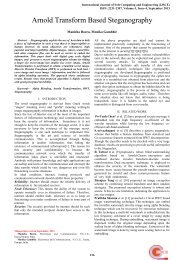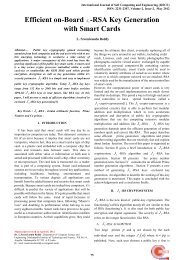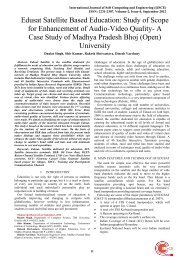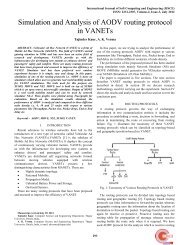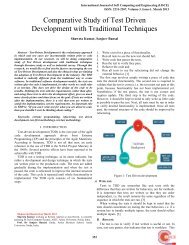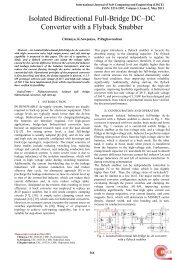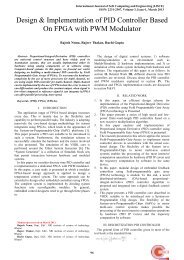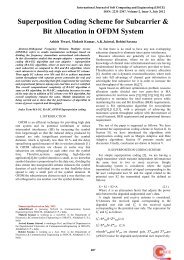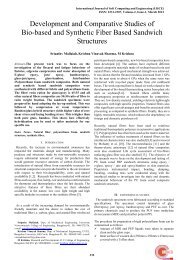Study on Dual Wide Band Frequency Selective Surface for Different ...
Study on Dual Wide Band Frequency Selective Surface for Different ...
Study on Dual Wide Band Frequency Selective Surface for Different ...
You also want an ePaper? Increase the reach of your titles
YUMPU automatically turns print PDFs into web optimized ePapers that Google loves.
Internati<strong>on</strong>al Journal of Soft Computing and Engineering (IJSCE)<br />
ISSN: 2231-2307, Volume-2, Issue-6, January 2013<br />
<str<strong>on</strong>g>Study</str<strong>on</strong>g> <strong>on</strong> <strong>Dual</strong> <strong>Wide</strong> <strong>Band</strong> <strong>Frequency</strong> <strong>Selective</strong><br />
<strong>Surface</strong> <strong>for</strong> <strong>Different</strong> Incident Angles<br />
P. Samaddar, S. De, S. Sarkar, S. Biswas, D.C. Sarkar, P.P. Sarkar<br />
Abstract: This paper deals with single layer <strong>Frequency</strong><br />
selective surface (FSS) which acts as a double band reject filter.<br />
The two stop bands are really broad with percentage bandwidth<br />
of 26.67% and 14.53%. The maximum and minimum band<br />
separati<strong>on</strong> <strong>for</strong> this proposed design is around 45 dB and<br />
frequency ratio is more than 1.9.This results are almost same <strong>for</strong><br />
different incident angles.. This design is investigated theoretically<br />
by ANSOFT® Designer software and practically by standard<br />
microwave test bench and the both results show a good<br />
agreement.<br />
Keywords: <strong>Frequency</strong> <strong>Selective</strong> <strong>Surface</strong>; <strong>Band</strong> reject filter,<br />
<strong>Band</strong> separati<strong>on</strong>, <strong>Frequency</strong> ratio.<br />
I. INTRODUCTION<br />
For more than four decades, <strong>Frequency</strong> <strong>Selective</strong> <strong>Surface</strong>s<br />
(FSSs) have been widely studied <strong>for</strong> their various<br />
applicati<strong>on</strong>s in spatial microwave and optical filters. They<br />
are being used as polarized filters, sub reflectors, band-pass<br />
hybrid radomes <strong>for</strong> radar cross secti<strong>on</strong> (RCS) c<strong>on</strong>trolling [1-<br />
4]. These surfaces are periodic arrays of strip (dipole) <strong>on</strong> a<br />
dielectric slab or slot within a metallic screen, which behave<br />
as band stop or band pass filters, respectively. Several such<br />
grid geometries have been dem<strong>on</strong>strated, including arrays of<br />
annular and square rings, dipoles, tripoles, crosses, and<br />
Jerusalem crosses [5,6]. Ring slot frequency-selective<br />
surfaces (FSS) have been widely investigated in recent years<br />
[7-9]. In reference [8] they report a four-band FSS design<br />
<strong>for</strong> the NASA CRAF/CASSINI applicati<strong>on</strong>, that use of<br />
multiple RF frequencies <strong>for</strong> science investigati<strong>on</strong>s and data<br />
communicati<strong>on</strong>s links.<br />
This paper presents some FSS designs which have square<br />
patch with c<strong>on</strong>centric annular ring slots. Ef<strong>for</strong>t has been<br />
given to make a double band FSS which can stop C and Ku<br />
bands <strong>for</strong> different incident angles with good percentage<br />
bandwidth and high band separati<strong>on</strong>. These bands are used<br />
in satellite communicati<strong>on</strong> and this microwave band stop<br />
filter can be used in this field. This paper actually introduces<br />
four designs, where every design is the modificati<strong>on</strong> of the<br />
previous design and the last (fourth design) <strong>on</strong>e is the best<br />
am<strong>on</strong>g those and nearest to our requirement. The results <strong>for</strong><br />
different incident angles are studied <strong>for</strong> this design.<br />
Manuscript received <strong>on</strong> January, 2013.<br />
P.Samaddar, Department Engineering and Technological Studies,<br />
University of Kalyani, Kalyani, Nadia, India.<br />
S.De, Department Engineering and Technological Studies, University of<br />
Kalyani, Kalyani, Nadia, India.<br />
S.Sarkar, Department Engineering and Technological Studies,<br />
University of Kalyani, Kalyani, Nadia, India.<br />
S. Biswas, Department Engineering and Technological Studies,<br />
University of Kalyani, Kalyani, Nadia, India.<br />
D.C. Sarkar, Department Engineering and Technological Studies,<br />
University of Kalyani, Kalyani, Nadia, India.<br />
P.P. Sarkar, Department Engineering and Technological Studies,<br />
University of Kalyani, Kalyani, Nadia, India.<br />
Every design is theoretically investigated by ANSOFT<br />
Designer / Nexxim v 2.2 software which uses method of<br />
Moment (MOM) process to calculate the results. To c<strong>on</strong>firm<br />
the simulated result, the FSS is fabricated and<br />
experimentally tested. Every FSS is designed with dielectric<br />
(FR4, relative permittivity of 4.4 and 1.6mm thickness) and<br />
metal (copper).<br />
II. DESIGN OF FSS<br />
In this secti<strong>on</strong> four FSS designs are introduced with<br />
different number of c<strong>on</strong>centric rings and circular slots. The<br />
first design has <strong>on</strong>ly <strong>on</strong>e ring slot but the fourth has two<br />
rings and <strong>on</strong>e circular slot. The size of the metallic square<br />
patches increases with the number of ring shaped slots.<br />
Single cells of the all four designs are shown in fig. 1.<br />
Though the number of rings is changed, the width of the ring<br />
and radius of circular slot are kept same as 1mm. By taking<br />
infinite array of these single cells (when the cells are kept<br />
2mm apart in both vertical and horiz<strong>on</strong>tal directi<strong>on</strong>) the<br />
result has been investigated by software. A small part of the<br />
fourth FSS is shown in Fig. 2. The periodicity in both<br />
horiz<strong>on</strong>tal and vertical directi<strong>on</strong> <strong>for</strong> the first design is 8mm,<br />
<strong>for</strong> sec<strong>on</strong>d design is 10mm, <strong>for</strong> third design is 12mm and <strong>for</strong><br />
fourth design is 14 mm At the time of experiment a 12cm *<br />
12cm (approximately) FSS having eight rows and eight<br />
columns is used. Figure 3 shows the fabricated FSS.<br />
Fig. 1. Single Cells of the Four FSS<br />
342
Normalized Transmitted Electric<br />
Field (dB)<br />
Normalized Transmitted Electric Field<br />
(dB)<br />
Normalized transmitted<br />
Electric Field (dB)<br />
Normalized Transmitted<br />
Electric Field (dB)<br />
Normalized Transmitted Electric<br />
Field (dB)<br />
<str<strong>on</strong>g>Study</str<strong>on</strong>g> <strong>on</strong> dual wide band frequency selective surface <strong>for</strong> different incident angles<br />
Graph <strong>for</strong> First Design<br />
Sec<strong>on</strong>d Design<br />
0<br />
-5 0 5 10 15 20 25 30<br />
-10<br />
-15<br />
-20<br />
-25<br />
-30<br />
-35<br />
-40<br />
-45<br />
-50<br />
<strong>Frequency</strong> (GHz)<br />
Fig. 2. FSS with C<strong>on</strong>centric Annular Slots (Fourth<br />
Design)<br />
Graph <strong>for</strong> Sec<strong>on</strong>d Design<br />
Third Design<br />
0<br />
3.5 8.5 13.5 18.5 23.5<br />
-10<br />
-20<br />
-30<br />
-40<br />
-50<br />
<strong>Frequency</strong> (GHz)<br />
Graph <strong>for</strong> Third Design<br />
Fourth Design<br />
Fig.3. Fabricated FSS<br />
III. RESULT<br />
The simulated results <strong>for</strong> all the four designs are shown in<br />
table 1. A normalized electric field vs. frequency graph <strong>for</strong><br />
all designs is shown in fig 4. By this graph it can be shown<br />
that bands are shifting left with every modificati<strong>on</strong>. The<br />
fourth design provides the best result, so it is fabricated and<br />
practically investigated. The resp<strong>on</strong>se <strong>for</strong> different incident<br />
angle, starting from 0° to 60° with an interval of 10° is also<br />
investigated and shown in table 3. The practical<br />
investigati<strong>on</strong> is d<strong>on</strong>e by standard microwave test bench.<br />
Agilent made microwave generator is c<strong>on</strong>nected to a<br />
transmitting horn. Receiving horn antenna is c<strong>on</strong>nected to an<br />
Agilent made power meter (model no E4418 B, EPM Series<br />
Power Meter) with sensor (model no E4412 A, E Series CW<br />
Power Sensor). The horn antennas and generators are<br />
changed <strong>for</strong> different frequencies bands like 4GHz – 6GHz,<br />
6GHz - 8GHz, 8GHz - 12GHz etc. Both the practical and<br />
theoretical results <strong>for</strong> the fourth design are shown in the<br />
table 2 and transmissi<strong>on</strong> characteristic is shown in Fig.6.<br />
0<br />
-20<br />
-30<br />
-40<br />
-50<br />
-60<br />
First Design<br />
0 5 10 15 20 25 30<br />
-10<br />
<strong>Frequency</strong> (GHz)<br />
0<br />
3.5 8.5 13.5 18.5<br />
-10<br />
-20<br />
-30<br />
-40<br />
-50<br />
<strong>Frequency</strong> (GHz)<br />
Graph <strong>for</strong> Fourth Design<br />
Fig. 4 Normalized transmitted Electric field graph <strong>for</strong><br />
four FSS<br />
Practical data<br />
Theoretical Data<br />
0<br />
-5 0 5 10 15 20<br />
-10<br />
-15<br />
-20<br />
-25<br />
-30<br />
-35<br />
-40<br />
-45<br />
-50<br />
<strong>Frequency</strong> (GHz)<br />
Fig 6. Normalized transmitted Electric field vs.<br />
frequency graph <strong>for</strong> fourth FSS (Simultaneously<br />
simulated and measured results )<br />
Parameters<br />
Name of FSS<br />
Res<strong>on</strong>ating<br />
<strong>Frequency</strong><br />
(GHz)<br />
<strong>Band</strong>width<br />
(GHz)<br />
Percentage<br />
<strong>Band</strong>width<br />
First Design 18.31 4.96 27.09<br />
Sec<strong>on</strong>d 12.01 3.41 28.39<br />
Design 25.31 0.53 2.1<br />
Third Design 8.9 2.44 27.42<br />
18.73 2.64 14.09<br />
Fourth 6.9 1.84 26.67<br />
Design 13.21 1.92 14.53<br />
Table. 1. Simulated results <strong>for</strong> the four FSS designs<br />
341
Internati<strong>on</strong>al Journal of Soft Computing and Engineering (IJSCE)<br />
ISSN: 2231-2307, Volume-2, Issue-6, January 2013<br />
Res<strong>on</strong>ating<br />
<strong>Frequency</strong> (GHz)<br />
Theoretical Results Practical Results<br />
6.9 7<br />
13.21 13<br />
<strong>Band</strong>width (GHz) 1.84 2.6<br />
Percentage<br />
<strong>Band</strong>width<br />
1.92 2.8<br />
26.67 37.14<br />
14.53 21.54<br />
Table 2. Theoretical and measured results <strong>for</strong> Fourth<br />
FSS<br />
Inc<br />
First <strong>Band</strong><br />
Sec<strong>on</strong>d Result<br />
ide<br />
nt<br />
Theoretical<br />
Result<br />
Practical<br />
Result<br />
Theoretical<br />
Result<br />
Practical<br />
Result<br />
An<br />
gle<br />
Res<strong>on</strong><br />
ating<br />
Fr.<br />
GHz<br />
Ban<br />
dwid<br />
th<br />
GHz<br />
Reso<br />
natin<br />
g Fr<br />
GHz<br />
Ban<br />
dwid<br />
th<br />
GHz<br />
Res<strong>on</strong><br />
ating<br />
Fr.<br />
GHz<br />
Ban<br />
dwid<br />
th<br />
GHz<br />
Res<strong>on</strong><br />
ating<br />
Fr.<br />
GHz<br />
Ban<br />
dwid<br />
th<br />
GHz<br />
0° 6.9 1.84 7 2.6 13.21 1.92 13 2.8<br />
10° 7 1.91 7.1 2.5 13.16 1.81 13.2 2.7<br />
20° 6.89 1.83 6.99 2.61 13.16 1.86 13.12 2.74<br />
30° 6.89 1.8 7 2.5 13.17 1.84 13.2 2.8<br />
40° 6.89 1.83 6.88 2.6 13.16 1.85 13.19 2.75<br />
50° 6.89 1.78 6.9 2.55 13.16 1.83 13 2.8<br />
60° 6.89 1.78 7 2.4 13.16 1.81 13.12 2.75<br />
Table 3. Theoretical and measured results at different<br />
incident Angle <strong>for</strong> Fourth FSS<br />
IV. CONCLUSION<br />
Here dual band stop frequency selective structure has been<br />
designed. Both the bands are wide. The most important<br />
points to menti<strong>on</strong> here are that the separati<strong>on</strong> between<br />
transmissi<strong>on</strong> and reflecti<strong>on</strong> band is around 40 dB and the<br />
higher to lower frequency band ratio is 1.9. The novelty of<br />
the paper is that four goals (Broad band, multi band, good<br />
ratio between higher and lower band, good band separati<strong>on</strong>)<br />
are achieved simultaneously in the design of a single layer<br />
FSS structure. Another important point is the independency<br />
of the structure with respect to the change in incident angles.<br />
V. ACKNOWLEDGEMENT<br />
This research work was funded by DST PURSE<br />
PROJECT.<br />
REFERENCE<br />
[1] H. Zhou, S. Qu, Z. Pei, J. Zhang, B. Lin, J. Wang, H. Ma and C. Gu,<br />
Narrowband <strong>Frequency</strong> <strong>Selective</strong> <strong>Surface</strong> Based <strong>on</strong> Substrate<br />
Integrated Waveguide Technology, Progress In Electromagnetics<br />
Research Letters, Vol. 22, 19-28, 2011, pp 19-28.<br />
[2] N.D. Agrawal and W.A. Imbraile, Design of a dicroic Cassegrain<br />
subreflector, IEEE Trans Antennas Propagat AP-27 Ž1979, pp. 466-<br />
473.<br />
[3] S.W. Lee et al., Design <strong>for</strong> the MDRSS tri band reflector Antenna,<br />
IEEE Int AP-S Symp, Ontario, Canada, 1991, pp. 666-669.<br />
[4] G.H. Schennum, <strong>Frequency</strong> selective surfaces <strong>for</strong> multiple<br />
frequency antennas, Microwave J 16, 1973, pp. 55-57.<br />
[5] Michael E. MacD<strong>on</strong>ald,Angelos Alexanian, Robert A. York, Zoya<br />
Popovic and Erich N. Grossman, Spectral Transmittance of Lossy<br />
Printed Res<strong>on</strong>ant-Grid Terahertz <strong>Band</strong> pass Filters, IEEE<br />
TRANSACTIONS ON MICROWAVE THEORY AND<br />
TECHNIQUES, VOL. 48, NO. 4, APRIL 2000, pp 712-718.<br />
[6] J. Huang and S.W. Lee,"Tri-<strong>Band</strong> <strong>Frequency</strong> <strong>Selective</strong> <strong>Surface</strong><br />
with Circular Ring Elements" IEEE Int. AP- Symp., L<strong>on</strong>d<strong>on</strong>, Ontario,<br />
Canada, June 24-28, 1991.<br />
[7] A.E. Martynyuk and J.I. Martinez Lopez, <strong>Frequency</strong>-selective<br />
surfaces based <strong>on</strong> shorted ring slots, ELECTRONICS LETTERS 7st<br />
March 2007 Vol. 37 No. 5.<br />
[8] T.K. Wu, K. Woo, S.W. Lee, Multi-ring element <strong>Frequency</strong> <strong>Selective</strong><br />
<strong>Surface</strong> <strong>for</strong> multi-band applicati<strong>on</strong>, IEEE, vol- 4, page- 1775-1778,<br />
1992.<br />
[9] Parker, E.A.; Hamdy, S.M.A.; Langley, R.J.; , "Arrays of c<strong>on</strong>centric<br />
rings as frequency selective surfaces," Electr<strong>on</strong>ics Letters , vol.17,<br />
no.23, pp.880-881, November 12 1981.<br />
Srija De obtained her M.Tech from Jadavpur University<br />
in the year 2011. She earned her M.Sc in Electr<strong>on</strong>ics<br />
Science from Pt.R.S.S.University, Raipur in the year<br />
2009. Also, she obtained her B.Sc in Physics H<strong>on</strong>s.<br />
from Calcutta University in the year 2007. She is<br />
presently working towards her PhD at the D.E.T.S,<br />
University of Kalyani.<br />
P. Samaddar obtained her M.Tech from the D.E.T.S in<br />
University of Kalyani in the year 2012 .She earned her<br />
B.tech in Electr<strong>on</strong>ics and Instrumentati<strong>on</strong> from the same<br />
Department in University of Kalyani in the year 2010.<br />
She is presently doing her Ph.D in from the same dept.<br />
in University of Kalyani. She is an Associate of the<br />
Instituti<strong>on</strong> of Engineers (India).<br />
S. Sarkar obtained his M.Tech from Kalyani Govt.<br />
Engineering College in the year 2010. He earned his<br />
B.E in ECE from Bengal Engineering and Science<br />
University, Shibpur in the year 2008. He is presently<br />
working towards his PhD at the D.E.T.S, University of<br />
Kalyani as CSIR SRF. He is an Associate of the<br />
Instituti<strong>on</strong> of Engineers (India).<br />
Dr. S. Biswas obtained his Ph.D in engineering from<br />
Jadavpur University in the year 2004. He obtained his<br />
M.E from Jadavpur University and B.E from Bengal<br />
Engineering College in the year 1994 and 1990<br />
respectively. He is presently working as Scientific<br />
Officer (Associate Professor Rank) at the D.E.T.S,<br />
University of Kalyani. He has more than 14 years of teaching experience.<br />
Dr. Debasree Sarkar obtained her Ph.D in Engineering<br />
from Jadavpur University in the year 2005. She has<br />
obtained her M.E. from Bengal Engineering College in<br />
the year 1994. She earned her B.E. degree in<br />
Electr<strong>on</strong>ics and Telecommunicati<strong>on</strong> Engineering from<br />
Bengal Engineering College in the year 1991. She is<br />
presently working as Scientific Officer at the D.E.T.S,<br />
University of Kalyani.<br />
Dr. Partha Pratim Sarkar obtained his Ph.D in<br />
Engineering from Jadavpur University in the year 2002.<br />
He has obtained his M.E. from Jadavpur University in<br />
the year 1994. He earned his B.E. degree in Electr<strong>on</strong>ics<br />
and Telecommunicati<strong>on</strong> Engineering from Bengal<br />
Engineering College in the year 1991. He is presently<br />
working as Senior Scientific Officer (Professor Rank)<br />
at the D.E.T.S, University of Kalyani. His area of<br />
research includes Microstrip Antenna, microstrip Filter,<br />
<strong>Frequency</strong> <strong>Selective</strong> <strong>Surface</strong>s and Artificial Neural Network. He has<br />
c<strong>on</strong>tributed to numerous (more than 130 publicati<strong>on</strong>s) research articles in<br />
various journals and c<strong>on</strong>ferences of repute. He is a life fellow of IETE, and<br />
fellow of IE(India).<br />
342



